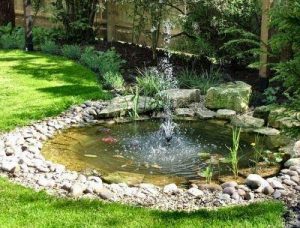Having a water fountain in your front or back yard can be a great way to develop some personality on your property. Whether you are talking about a serene pond, these water fountains can go a long way towards making your place stand out among the crowd. While many water features might seem similar, there is one fundamental difference that we need to consider in the type of water pump you rely on—choosing the right water pump to order fountain pumps for your water feature.
Choosing the right fountain pump is just one aspect of creating a beautiful garden. There are many other elements to consider, from plant selection to layout design. Sometimes, a complete garden makeover might be necessary to achieve the desired look and feel. This process can be complex and time-consuming, but with professional help, you can transform your outdoor space into a stunning oasis.
A fountain and pond pumps don’t seem like two dramatically different applications. Why do we need to be careful in choosing the right water pump for their operation? Are there even any differences between the two styles of pumps? Water pumps are advanced pieces of equipment that work to help you circulate water in your reservoir. This water pump is charged with mere circulation and cycling duties in a pond. Here are some different types of garden fountain pumps:
Table of Contents
Feature Pumps:
Water feature pumps are used in many landscaping applications to help the functioning of a minor, natural pond or create a water feature. These pumps circulate water, improving water quality through aeration and creating fountains, waterfalls, and tumbling streams. Water features pumps are popular landscape elements and can range from small, simple ponds to elaborate combinations of features. They take two primary forms — submersible and non-submersible. Each type of pump has an intended use, and sub-types exist within these two groups.
A small designed pump operates features such as ornaments, pebble pool fountains or small self-contained features. If you want to order fountain pumps, these models come with selected fountain attachments as standard.
Submersible Pump:
This pump is known as an inaudible pump since the unit is submerged in the water. The pump forces water upwards, generally having water inlets either through an independent channel or on the side of the body. Since the pump is entirely submersed, it rarely overheats. The submersible pump is a preferred choice as it is easily installed and very enduring, the only disadvantage being that should the pump develop a fault, you must remove the unit from the water.
Submersible water fountain pumps are located directly in the water. A specialized submersible water pump is used to power a fountain, which may be connected directly to the pump or installed in another feature area.
External Pump:
This type of pump needs very little maintenance and is excellent for high head pressure and flow rates. However, these pumps can be very noisy and need extra protection from all elements to eliminate regular servicing. Pumps that are not created to be submersed are called external pumps. Such pumps work the same way as submersible water fountain pumps but are not protected against water and must be fixed in any protective enclosure. They perform the same function as a submersible water pump but must remotely draw water from the fountain through an intake pipe before pumping it to the desired destination. As electric devices, they are unsafe to the elements and accidental contact with water.
Solar Powered Pump:
The difference from traditional fountain pumps, as the name indicates, is that they are powered by the sun. As compared to any conventional pumps, solar pumps can be both submersible and external. They are environmentally friendly pumps and safe to operate, as no electricity is involved. The disadvantage of this kind of pump is that it is limited to sunny and warm environments; you cannot rely on its continued functionality on cloudy or rainy days if not supplied with good backup batteries.
Role of Fountain Pumps:
Fountain pumps are centrifugal pumps which move water using pressure from the centrifugal force created by the movement of an impeller. A fountain pump operates like a sump pump, except the water is fed back into the reservoir or pond rather than out of it. The water moves to a fountain device or an aerator that sprays water from the surface. The free-flowing water collects oxygen as it falls back to the bottom, providing aeration and allowing microbial action in the breakdown of wastewater or oxygenation for fish in ponds or farming tanks.
Fountain pumps supply water flow to fountains and devices used for aesthetic purposes and aeration in commercial, residential, and industrial applications. They may be configured for indoor or outdoor use and are typically differentiated by the pond size and whether the application is decorative or functional. Some fountain pumps are solar-powered and can work with an excellent pump to create a unique garden or landscape features such as waterfalls.
